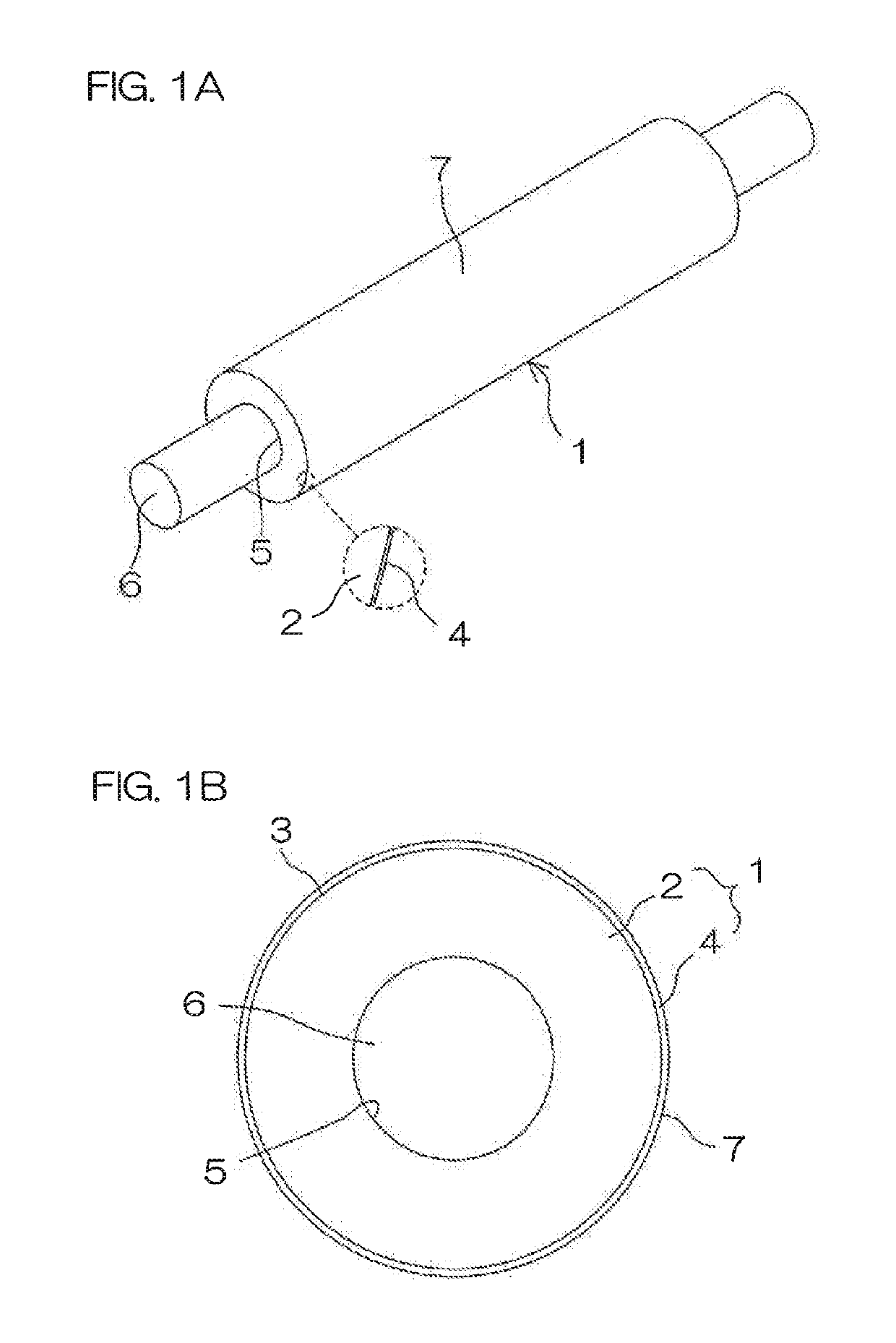Developing roller, and method of producing the same
a technology of developing rollers and rollers, which is applied in the direction of electrographic process, electrographic process apparatus, instruments, etc., can solve the problems of lateral toner leakage in a shorter period of time, toner is often liable to wear or damage, and toner is often liable to leak laterally from the opposite edge portions of the layer forming blade, etc., to achieve excellent slidability and wear resistance, and properly suppress the deterioration of toner
- Summary
- Abstract
- Description
- Claims
- Application Information
AI Technical Summary
Benefits of technology
Problems solved by technology
Method used
Image
Examples
example 1
[0148]Of ethylene propylene rubbers, an EPDM (ESPRENE EPDM 505A available from Sumitomo Chemical Co., Ltd. and having a Mooney viscosity ML1+4 (100° C.) of 47, an ethylene content of 50% and a diene content of 9.5%) was used as a rubber component.
[0149]DIANA PROCESS OIL PW-380 available from Idemitsu kosan Co., Ltd. was used as a paraffin oil.
[0150]While 100 parts by mass of the EPDM was simply kneaded by means of a Banbury mixer, 60 parts by mass of the paraffin oil and ingredients other than a crosslinking component and a foaming component shown below in Table 1 were added to and kneaded with the EPDM, and then the crosslinking component and the foaming component were added to and further kneaded with the resulting mixture. Thus, a semiconductive rubber composition for an inner layer was prepared.
[0151]
TABLE 1IngredientsParts by massFiller30Crosslinking assisting agent (I)5Crosslinking assisting agent (II)1Electron conductive agent50Foaming agent6Foaming assisting agent2Crosslinki...
example 2
[0168]A developing roller was produced in substantially the same manner as in Example 1, except that the proportion of the ADCA blended as the foaming agent in the semiconductive rubber composition was 5 parts by mass.
[0169]The tube for the outer layer had a wall thickness T of 100 μm, and an interference represented by a difference D1-D2 between the outer diameter D1 and the inner diameter D2 was 200 μm.
[0170]The developing roller had an overall Asker-C hardness of 45 degrees. The outer peripheral surface of the developing roller had a profile curve arithmetic average roughness Ra of 1 μm.
example 3
[0171]A developing roller was produced in substantially the same manner as in Example 1, except that the outer diameter D1 of the inner layer was 15.80 mm, and a seamless semiconductive thermoplastic polyamide elastomer tube SLV (available from Gunze Limited) having an inner diameter D2 of 15.60 mm and a wall thickness T of 200 μm was used for the outer layer.
[0172]As described above, the wall thickness T of the tube for the outer layer was 200 μm, and an interference represented by a difference D1-D2 between the outer diameter D1 and the inner diameter D2 was 200 μm.
[0173]The developing roller had an overall Asker-C hardness of 47 degrees. The outer peripheral surface of the developing roller had a profile curve arithmetic average roughness Ra of 1 μm.
PUM
| Property | Measurement | Unit |
|---|---|---|
| wall thickness | aaaaa | aaaaa |
| wall thickness | aaaaa | aaaaa |
| inner diameter D2 | aaaaa | aaaaa |
Abstract
Description
Claims
Application Information
 Login to View More
Login to View More - R&D
- Intellectual Property
- Life Sciences
- Materials
- Tech Scout
- Unparalleled Data Quality
- Higher Quality Content
- 60% Fewer Hallucinations
Browse by: Latest US Patents, China's latest patents, Technical Efficacy Thesaurus, Application Domain, Technology Topic, Popular Technical Reports.
© 2025 PatSnap. All rights reserved.Legal|Privacy policy|Modern Slavery Act Transparency Statement|Sitemap|About US| Contact US: help@patsnap.com


